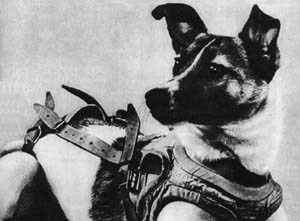There was little known in the 1950s about the effects of gravity in space. To research that, early rocket scientists used animals, particularly monkeys, chimps, and dogs, to ride spacecraft into space to determine how weightlessness affects a living being.1 Soviet canine recruiters began looking for female stray dogs for these experiments, because females were more capable of living in close confinement due to their smaller size, and female dogs were also more docile. To determine finalists for space missions, Soviet scientists placed their canines in small, pressurized capsules for days and weeks at a time, and taught them to eat a nutritious gel that would be provided to them during their space missions. If adapting well to the tests, doctors would monitor the finalists’ reactions to changes in air pressure and loud noises that would be associated with liftoff through a series of surgical procedures.2
In the heat of the Space Race against the United States, Soviet Premier Nikita Khrushchev announced a satellite to be launched to commemorate the 40th anniversary of Russia’s Bolshevik Revolution on November 7, 1957. Soviet rocket engineers went straight to work following Khrushchev’s announcement. Using what they learned from Sputnik I, launched only four weeks prior, Sputnik II included a pressurized compartment for their canine cosmonaut. With the final stage of the rocket attached, Sputnik II’s final weight was 1,120 pounds, and scientists concluded that only one meal for their cosmonaut would be permitted in order to stay within weight limits. However, what the world didn’t know was that Sputnik II was designed to only launch the cosmonaut in orbit without a means of returning, due to the rapidly approaching deadline set by Khrushchev.3

While she wasn’t the first animal to be sent to space, she was the first living being to orbit the Earth.4 Originally named Kudryavka, or Little Curly in Russian, Laika was introduced to the Soviet public via radio, where she barked and gained her better-known nickname Laika, meaning “barker” in Russian.5 Laika was a two-year-old, mixed Siberian husky stray found on the streets of Moscow. Soviet scientists sought after strays like Laika because they assumed that stray dogs already had the experience of enduring harsh conditions of cold temperatures and hunger, and she described as being calm and obedient. Her introduction to Soviet public radio sent shock waves throughout the world. Laika’s announcement sent British animal rights activists into a frenzy to make themselves known at the Soviet Embassy. First Secretary Yuri Modin, in response to their outcries, said, “The Russians love dogs. This has been done not for the sake of cruelty but for the benefit of humanity.” And in Germany, Laika gained the title, die Himmels-hündin, the She-Hound of Heaven.6 Laika was chosen as Sputnik II’s primary cosmonaut dog with Albina, meaning white, as her backup. It was rumored that Albina outperformed Laika in their trainings, but because Albina had recently given birth to puppies and won the affections of her caretakers, Laika became the top candidate to ride Sputnik II.
With the Premier’s announcement and his expectation, Laika’s training for the mission began immediately. She was fitted and trained in space suits. She was spun in a centrifuge to accustom her to changes in gravitation, and she learned to accept food and water in a jellied form that would be easily served in an environment without gravity. The most intensive of her training came when she was relocated to the Institute of Aviation Medicine in Moscow before relocating finally to the launch site.7 In late October in the days leading up to Laika’s mission, Vladimir Yazdovskiy, one of her caretakers, temporarily removed Laika from the training facility to his home to meet his family. “Laika was a wonderful dog…quiet and very placid. Before the flight to the cosmodrome [Baikonur], I once brought her home and she showed her to the children. They played with her. I wanted to do something nice for the dog. She had only a very short time to live, you see,” said Yazdovskiy. Laika didn’t know it, but this would be her last experience as a dog on Earth.8 On October 31, 1957, Laika went on her scheduled 10 a.m. walk and immediately began flight preparations afterward. She received a sponge bath with careful grooming and was marked where all her sensors were going to be placed. By noon, she was fitted with her required sensors, sanitation device, and fitted in her harness that restrained her before being placed in her shuttle. Laika’s three-day wait until launch had begun.

On November 3, 1957, at 5:30 a.m., Soviet scientists were given the go-ahead to launch Sputnik II. The satellite lifted off with G-forces reaching five times normal gravity levels. The noises and changes in pressure scared Laika. Her heartbeat had tripled its normal rate and her breath rate nearly quadrupled upon liftoff.9 In an effort to curb international outcry, Soviet officials reported that Laika had died painlessly after spending a week in orbit from euthanization. By November 10, Sputnik II’s batteries had run out and stopped transmitting data back to Earth. With all systems down, the spacecraft continued to orbit the Earth until April 14, 1958, when it re-entered the atmosphere, bringing the total time spent in space to 162 days.10
At the fall of the Soviet Union, numerous reports were declassified that revealed Laika’s actual fate. Oleg Gazenko, medical doctor and space dog trainer, revealed in 1993 that Sputnik II’s heat shield was lost entering orbit, which caused an unexpected rise in temperature in the satellite. Inside the shuttle, the temperatures rose over 90 degrees and gave the Soviets no expectation of Laika’s survival past the second orbit. She died soon after the launch from panic and overheating.11 In October 2002, Dimitri Malashenkov, one of the scientists involved in Sputnik II’s operation, revealed at the World Space Congress in Houston several new details to the world about Laika and her mission; however, the detail that stood out the most to the world was how Soviet scientists trained to adapt the dogs to similar conditions of Sputnik II. It was accomplished by placing them in gradually smaller cages for periods up to 15-20 days.12 Upon learning of Malashenkov’s revelations, Gazenko stated, “We did not learn enough from the mission to justify the death of the dog.”13

Many across the world protested the Soviet’s decision to allow Laika to die simply because the technology was not advanced enough to return her to Earth. Laika’s role in the development of space travel eventually led to cosmonaut Yuri Gagarin to man the first orbital flight of a human being and determined that a living being could withstand weightlessness for a period of time. For over half a century, Laika’s legacy was lauded as heroic through Soviet propaganda. Monuments were built in her honor and her popularity was used to sell everything from children’s toys to cigarettes. Today, Laika’s legacy lives on in tributes in every industry from animation studios to periodicals, both named after her. Additionally, her story has inspired numerous forms of media in film and musical artistry.
- Elizabeth Dohrer, “Laika the Dog & the First Animals in Space,” Space.com, accessed April 27, 2021, https://www.space.com/17764-laika-first-animals-in-space.html ↵
- Alice George, “The Sad, Sad Story of Laika, the Space Dog, and Her One-Way Trip into Orbit,” Smithsonian Magazine, accessed April 26, 2021, https://www.smithsonianmag.com/smithsonian-institution/sad-story-laika-space-dog-and-her-one-way-trip-orbit-1-180968728/. ↵
- “Animals in Space,” NASA (website), accessed April 28, 2021, https://history.nasa.gov/animals.html. ↵
- Elizabeth Dohrer May 31 and 2017, “Laika the Dog & the First Animals in Space,” Space.com, accessed April 27, 2021, https://www.space.com/17764-laika-first-animals-in-space.html. ↵
- “Laika | Background, Spaceflight, & Facts,” Encyclopedia Britannica, accessed April 27, 2021, https://www.britannica.com/topic/Laika. ↵
- “ANIMALS: The She-Hound of Heaven,” Time, November 18, 1957, http://content.time.com/time/subscriber/article/0,33009,868018,00.html. ↵
- Colin Burgess and Chris Dubbs, Animals in Space: From Research Rockets to the Space Shuttle (Springer Science & Business Media, 2007) https://books.google.com/books?id=xSdHVIpsrKkC&pg=PA164&lpg=PA164&dq=soon+after+launch+oleg+gazenko+1993&source=bl&ots=bPIhSZt0r1&sig=_UB5H-yBfT8QpBWXAdHVr1RCLMc&hl=en&sa=X&ved=0ahUKEwjg8Y3Aw63aAhVqT98KHeCXAgsQ6AEINzAC#v=onepage&q=laika&f=false. ↵
- Colin Burgess and Chris Dubbs, Animals in Space: From Research Rockets to the Space Shuttle (Springer Science & Business Media, 2007) https://books.google.com/books?id=xSdHVIpsrKkC&pg=PA164&lpg=PA164&dq=soon+after+launch+oleg+gazenko+1993&source=bl&ots=bPIhSZt0r1&sig=_UB5H-yBfT8QpBWXAdHVr1RCLMc&hl=en&sa=X&ved=0ahUKEwjg8Y3Aw63aAhVqT98KHeCXAgsQ6AEINzAC#v=onepage&q=laika&f=false. ↵
- Alice George, “The Sad, Sad Story of Laika, the Space Dog, and Her One-Way Trip into Orbit,” Smithsonian Magazine, accessed April 26, 2021, https://www.smithsonianmag.com/smithsonian-institution/sad-story-laika-space-dog-and-her-one-way-trip-orbit-1-180968728/. ↵
- Elizabeth Dohrer May 31 and 2017, “Laika the Dog & the First Animals in Space,” Space.com, accessed April 27, 2021, https://www.space.com/17764-laika-first-animals-in-space.html. ↵
- Alice George, “The Sad, Sad Story of Laika, the Space Dog, and Her One-Way Trip into Orbit,” Smithsonian Magazine, accessed April 26, 2021, https://www.smithsonianmag.com/smithsonian-institution/sad-story-laika-space-dog-and-her-one-way-trip-orbit-1-180968728/. ↵
- “Sputnik-2, More News from Distant History,” accessed April 27, 2021, http://www.svengrahn.pp.se/histind/Sputnik2/sputnik2more.html. ↵
- Colin Burgess and Chris Dubbs, Animals in Space: From Research Rockets to the Space Shuttle (Springer Science & Business Media, 2007) https://books.google.com/books?id=xSdHVIpsrKkC&pg=PA164&lpg=PA164&dq=soon+after+launch+oleg+gazenko+1993&source=bl&ots=bPIhSZt0r1&sig=_UB5H-yBfT8QpBWXAdHVr1RCLMc&hl=en&sa=X&ved=0ahUKEwjg8Y3Aw63aAhVqT98KHeCXAgsQ6AEINzAC#v=onepage&q=laika&f=false ↵



27 comments
Tomas Salazar
It is tragic that Laika died due to the reason of insufficient technology to bring her back home safely. I had no idea this has happened, it was a very informational article and a pleasure to read. I never knew the Soviets sent an animal to space, but I think it is cruel to send an animal into space with zero intention of bringing that animal back to Earth safely. I think it is slightly violating animal rights, a true tragedy. The article was very informative again, you did a phenomenal job writing this article. Rest in Peace, Laika.
Nydia Ramirez
Wow! I had not heard of this story ever in my life. Thank you so much for bringing it to my attention.The fact that Laika’s role in the development of space travel eventually led to cosmonaut Yuri Gagarin to man the first orbital flight of a human being is mind-blowing. Without Laika it would not have been determined that a living being could withstand weightlessness for a period of time. It is said that it took a pure dog dying in order to make a discovery however, it is comforting to know that we are still honoring her and research is better now than it once was.
Matthew Gallardo
I knew only a little about the story of Laika before, and I knew she sadly died during the operation, but the fact that the soviets never planned for her to return home, and that she died soon after launch, is a saddening piece of information. The fact that they hid this information until the dissolution of the USSR is not surprising, from how much of a disaster it would have been to admit such a thing. I wish that the soviets thought things through more and took Laikas health into concern when sending her into space, especially for something so important for the advancement of science.
Erick Velazquez
I heard the story of Laika first when I was in middle school. At first I was confused by also interested in Laika’s adventure through space. It was very disturbing hearing about how they did not expect/plan to have Laika land safely back to Earth. And it’s unfortunate of what happened to Laika and very disgusting as to the cruelty of animals used for such tests. Though, many of these animals, such as Laika, live on in memory.
Jourdan Carrera
The story of Laika’s great journey into the heavens is one that I have known about ever since I was a child. I knew that she was a stray dog from Moscow, however I was not aware at all the extensive training that went into getting her onto the space craft and into orbit. I had always just thought that she was just put into the space craft randomly with not training. It is unfortunate that she passed away after the launch due to the heat and that the Soviets had not plan to actually bring her back. However I am glad her memory lives on with us, even if she died in an unfortunate way.
Trenton Boudreaux
A very interesting perspective on such an important dog. It’s a shame she died in launch, but that would probably be preferable to starving to death while in orbit. I never heard much about Lakita, other than the fact that she died in space, but I wasn’t aware that even back then, animal rights groups held concern over animal testing.
Karla Fabian
This was a very informational article about Laika, of which I had some brief knowledge prior, but not in such complete detail. It is fascinating to see how this dog went from being a stay to the first living being to orbit the Earth. Also, it is interesting that she was given the name “Laika,” meaning “barker” in Russia. Also, I always assumed that scientists who used dogs for experiments would try to find breed dogs who were well trained; I never thought they would use a stray, and seeing their explanation makes much sense. Contemplating that strays were assumed to be more enduring in harsh conditions of cold temperatures and hunger. It was very interesting to see how Laika was under this strenuous trainings and remained calm and obedient. It was unfortunate to read about Laikas’s death due to the conditions in the satellite. It is shocking to read that the real reason for Laikas’s death was known after 30 years, which also resulted in critics being launched to the Soviets for not bringing her back, acknowledging that the conditions were not favorable for her survival.
Martha Nava
As much as I loved this article, it still made me cry.. It is so heart-rending the way Laika died and had no idea what was happening as she went up to space. I’m also glad that you included evidence that organizations were against the use of a dog for space travel since at first, I was under the impression that everyone was on board with it (sending an animal to die in space). It’s also interesting to hear how they trained the animals for their missions. I also can’t believe that almost 30 years after the mission they found out the real reason for her death. Laika and every animal that went to space were truly hero’s whether they knew it or not. I also like that you included information on how new missions were to be held with humans in the future. Space travel has truly advanced so much. Overall, this is an amazing article, Mia! I think it included just the right amount of information and everything was related to each other, including the pictures.
Daniela Iniguez-Jaco
This story left me in tears, I was shattered when I first heard about Laika. It was heartbreaking to read that the mission was not supposed to come back down to Earth because the technology was not advanced yet. However, what breaks me the most is the fact that she thought she finally had a home when she met her trainer’s, Vladimir Yazdovskiy, family. Laika will always be remembered and she will always be a good dog.
Santos Mencio
I knew the Soviets sent a dog into space first, but I didn’t know all of the details of the event. I’m sure the fate of Laika will always be up for debate arguing that it was for the good of science and the other arguing that it was an animal rights violation. But I’m sure one thing we can all agree on is that Laika was a hero.